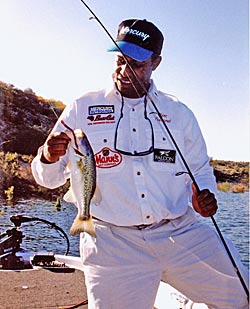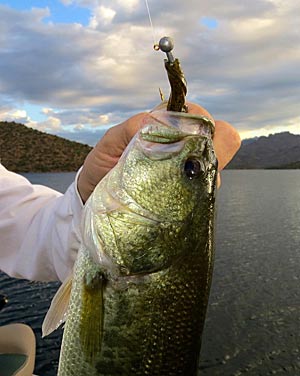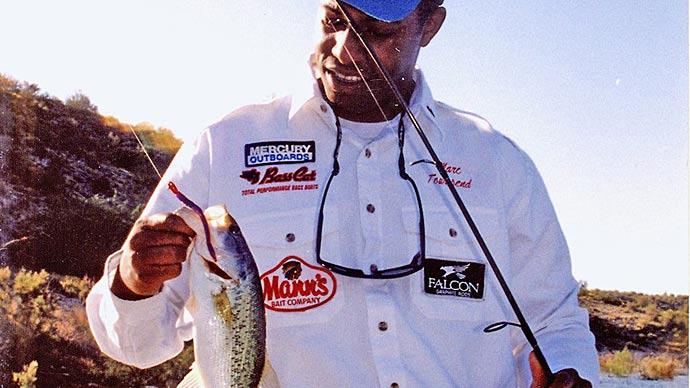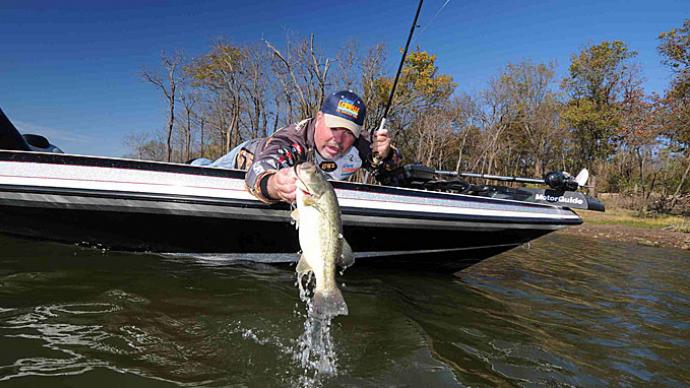
When I first began bass fishing, the thing I found hardest was fishing plastic worms. When you Texas rig a worm, it can be difficult to detect bites when you are just starting – when a worm bumps into a branch or a rock, it can feel like a bite. Then again, an actual bite sometimes doesn’t feel like anything – your line may move off sideways. If you are fishing in weeds, then the Texas rig is the way to go, but if you are fishing pilings, rip-rap, rock piles, bluffs, or even mud, there’s an easier way.
Open Hooks
An open hook can be practically self-setting if you use the right hook. A straight, light wire hook works well. I like a light wire hook because it can often be straightened out with constant pressure, meaning that you can get it off most snags. This takes much more pressure than a swimming fish puts on it unless that fish is enormous. The easiest way to fish with an open hook is to use a small jig head. Jig heads are available in an almost endless variety of colors, weights, and shapes. You can also paint them yourself. One California angler I know starts with plain lead pea heads, flattens them with a hammer, the paints them himself. Sometimes he glues eyes on them, and you can get eye stickers made for lures.
Dart heads are great for swimming a worm – they give it more action and fall differently than a round pea head jig.
Gear

A good dart or pea head worm rod is a six and a-half or seven-foot spinning rod with a little “give” to it. A too stiff rod will tend to make you lose more fish, either by tearing the hook free or straightening it out. Light line is best, and most anglers use 8- to 10-pound-test line no matter how shallow or deep they are fishing. Use a limp line to make casting easy. Some guys use braid, but I’ve always stuck to mono because it has a bit of stretch. Being able to see what your line is doing helps quite a bit.
Fishing Dart Heads
The biggest mistake you can make with a dart head is to start fishing too soon. When you cast it out, let it fall with the bail open until you see the line go slack – this means it has hit bottom. While the jig is falling, watch your line. If it jumps, bows, or moves sideways, a fish has probably sucked it in. Usually, they are heading away from you, but once in a while, you’ll get one that heads right for the boat. In any case, you should be able to see from the line movement that it isn’t falling naturally. Just reel. I find it helpful to keep a couple of fingers ahead of the reel to keep some tension on the line. This goes a LONG way toward preventing those awful loops you sometimes get on a spinning reel.
Once you’ve caught up with the fish, he’ll set the hook on himself. Steady pressure makes those small thin hooks slide right in. A reasonably big spool on your reel will help you take up line quickly and catch up with the fish. Just keep pressure on him once he’s hooked, and try not to switch the rod back and forth – that allows him to come off. A net is a dart head fisherman’s best friend – don’t try slinging him in over the side, or 10 to 1, he’ll come off. Either lip him or net him.
If you’re fishing vertical structure, cast the lure close to the piling, and let it fall. If the water by the piling is really deep, odds are he will take it on the way down. If there is current, toss to the upstream side and let the current take it around on the slack line. We once caught twenty-eight smallmouth off a single ledge at Lake Powell over eighty feet of water. The fish were only 25 feet deep and inhaled the dart heads every time. They were annihilating Yamamoto grubs.
Hopping
Years ago, I was fishing a tournament with a Tucson pro, and he taught me a fantastic method for fishing those “nothing” banks that most fishermen pass by. This was at Roosevelt Lake, and he pulled up to a stretch of a bank with nothing on it. It was about a 45-degree slope and had the occasional rock but nothing spectacular. He handed me a Press-Ur-Bite worm. These worms are no longer made, but they were like Westy Worms – two hooks on a worm, the first a light jig head with a gold, bendable wire. He just tossed it to the bank, barely in the water, and let the line slack. Then he’d reel just enough to pick the lure up, stop, and let it fall. I don’t even remember how many fish we caught off that bank, but it was a lot. I never felt a thing – just when I’d go to reel up to move it, a fish would be on it. Just pressure. Hence the name Press-Ur-Bite.

You can also hop a little jig head on the bottom like this – just reel, let it sink, and reel again. The bite can be simply pressured like it was for us that day, or they may slam it and take off. The key is to use the reel to move the bait – that keeps it subtle and keeps you in a position to reel and set. A lot of times, you will discover what the fish want by accident. For instance, you may get snagged on a small rock, and a fish grabs it when you pull the lure free. Or you may get a loop in your line, and while sitting there playing with your reel, a fish may take your worm. Sometimes the bass want the lure worked fast, and you may not realize it until a fish grabs it as you reel in quickly to throw it to another spot. It is essential to pay attention to where and how the lure was taken. If you can repeat the process, you can probably catch more fish.
Lures
The original Westy Worms were made with super floater worms, which are excellent because they float up off the bottom. Colors were limited back then, but we still caught tons of fish on them. Using a little jig head, you can choose any lure you want. Keep it small. For swimming or fishing vertical stuff, grubs are a good choice. Yamamoto grubs are my favorite because the thin tail has tons of swimming action, and they are so salty the fish hang on tight.
For hopping on the bottom or down banks, a 4-inch worm is ideal. Bigger worms can overpower the small jigs. With the old double-hooked worms, we’d often cut the back hook off, slit the worm down the middle about halfway up, then use a Wormizer to weld a piece of the tail in the slit to keep it open. Seriously though, you could use a small craw, which would work great. There are many incredible floating baits – floating means that the claws or the tail will stay up off the bottom, making the lure more visible.
Final Tips
I have known guys catch fish on dart and pea heads with almost any retrieve you can imagine. At a tournament weigh-in years ago, John Murray once told me he caught all his fish on a Westy, ripping it like a jerkbait under the tires in the marina. You never know. Once you have one on, though, don’t give him any slack, don’t change directions, and try not to let him jump. Danny Westfall (inventor of the Westy) kept his drag set light and used his hand on the spool to reel-set. Once the hook was in, he’d let go and allow the light drag to get the fish ready to boat.
If you’re having trouble catching fish on a traditional Texas rig, don’t feel like the Lone Ranger – many of us had the same problem starting. Just get a handful of small jigs and some light baits, and you’ll catch fish on plastics in no time.
BassResource may receive a portion of revenues if you make a purchase using a link above.




